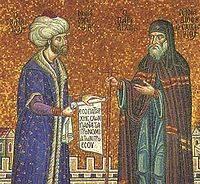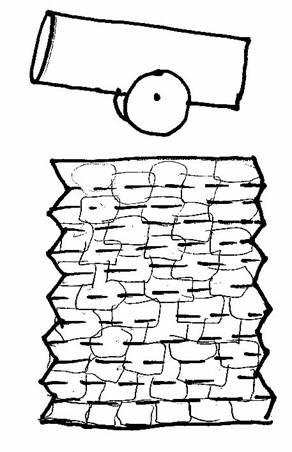Fall of Constantinople
FALL OF CONSTANTINOPLE

Objectives:
- Students should know that 1000 years after the fall of Rome, Constantinople fell to the Moslems named Turks.
- Students should have some idea why this is important in history.
Possible Lesson Plan:
- Open with prayer.
- Tell the story of the Fall of Constantinople:
In 1451 the Moslem Turks had a new king, Mehmet. Mehmet had only one idea in his mind; he told his generals, “There is only one thing I want: Give me Constantinople!” Mehmet was sure he could conquer the great capital of the Byzantine Empire. So, he gathered a great army to prepare for his attack, and built huge numbers of ships until he had the greatest navy in the East. He also built a great cannon, so big that it had to be drawn by 60 oxen and loaded by 200 men. No city had ever been attacked by a cannon before.
Constantinople, weakened by the Crusaders, had only an army of 8000 soldiers and 30 ships. But, the city was built on a peninsula —— a strip of land surrounded on three sides by the sea. There were huge walls around the whole city; these had held off many Moslem armies over hundreds of years.
Mehmet moved his army into place on the day after Easter in 1453. He asked the Emperor to surrender and give the city to the Moslems; the Emperor would not give up that easily. Soon the huge cannons were pounding the walls, but the walls held. Mehmet’s ships held the waterways and kept food from reaching the city. But, he could not enter the city. Finally, Mehmet built a huge pontoon bridge across the water. Now his armies could attack from both sides. The Christians were hungry and weak. But, they continued to fight.
Finally, the Turks prepared for their last big attack. The Emperor spoke to his people and told them to be ready to die for their Lord and their homes. Then the Christians all took communion in the many churches of the city and went to the walls to be ready for battle. In the middle of the night, Mehmet attacked. The thick walls of the city were no match for the huge cannon. This time his troops rushed up the walls of the city and charged into Constantinople. For three days, the Moslems sacked the city, killing all Christians they could find, stripping all the riches of the homes and churches, and burning whole sections of the wonderful city. The great Church of St. Sophia was renamed a Moslem mosque. The Byzantine Empire, outliving Rome by a thousand years, was finally defeated.
Add the Fall of Constantinople to your timeline.
- Feed the Elephant True/False Questions:
True False
Mehmet was king of the Turks. Mehmet was Emperor of Constantinople.
Mehmet attacked with a cannon. Mehmet attacked with bows and arrows.
Mehmet conquered Constantinople. Mehmet ran away in fear.
- Discuss for a bit weapons of war. Boys will like this lesson. What weapons can they think of? What were some early weapons? (bows and arrows, spears) Draw them. How might an army attack a city like Constantinople with these weapons? How did a war with these weapons sound? Look? How might the city be defended? How would a city be built so as to be easy to defend? With the invention of gunpowder and cannons (and later, guns), all war was changed. How might an army with cannons attack a city? What about sound and sights now? War has now become noisy! How can the city be defended? Were castles and walls as important as before?
 Make the Walls of Constantinople: Take a piece of construction paper. Decorate like a stone wall and fold like a fan starting at one 9-inch end. Spread it out – the walls of the city. Collapse it and the walls fall down. If you want to be really fancy, take a toilet paper roll and two paper plates. Cover the roll with black construction paper and cut wheels from the plates. Attach wheels with brads to the cannon. You can staple the wall-fan inside the cannon muzzle as a handle and use the fan!
Make the Walls of Constantinople: Take a piece of construction paper. Decorate like a stone wall and fold like a fan starting at one 9-inch end. Spread it out – the walls of the city. Collapse it and the walls fall down. If you want to be really fancy, take a toilet paper roll and two paper plates. Cover the roll with black construction paper and cut wheels from the plates. Attach wheels with brads to the cannon. You can staple the wall-fan inside the cannon muzzle as a handle and use the fan!
- Close with prayer: Lord, give us the courage of those brave Christians in Constantinople when Mehmet attacked.